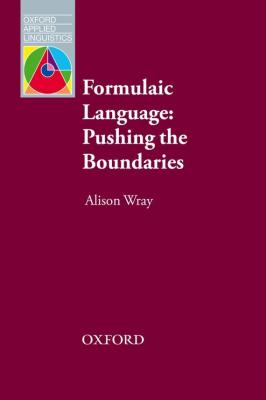ТОП просматриваемых книг сайта:
Formulaic Language. Alison Wray
Читать онлайн.Название Formulaic Language
Год выпуска 2013
isbn 9780194423090
Автор произведения Alison Wray
Жанр Зарубежная образовательная литература
Серия Oxford Applied Linguistics
Издательство Oxford University Press
a word or word string, whether complete or including gaps for inserted variable items, that is processed like a morpheme, that is, without recourse to any form-meaning matching of any sub-parts it may have.
The definition reflects specific claims about the nature and, by implication, provenance of formulaic material in a language – the claims that are presented in the next sections. It is not, therefore, the kind of definition that can really be used to go out and identify examples of formulaic language in real texts, or to find examples suitable for experimental investigations. The relationship between the MEU definition and that of another term used in this book, the ‘formulaic sequence’ (Wray 2002b: 9), is explored more fully in Chapter 8. A working definition of the terms, sufficient to apply in these earlier chapters, is given in a note in Chapter 1.
Three key conceptual claims about morpheme equivalent units
As noted above, the three key claims presented here summarize features of the model developed in Wray (2002b). It is this model that will provide the context for the interpretations of evidence in the remainder of the book.
The mental lexicon is heteromorphic
The theoretical position taken in this book, on the basis of evidence from multiple sources reviewed extensively in Wray (2002b), is that linguistic material is stored in bundles of different sizes (compare Jackendoff 2002: Chapter 6). That is, the mental lexicon contains not only morphemes and words but also many multiword strings, including some that are partly lexicalized frames with slots for variable material, treated as if they were single morphemes – they are MEUs (see definition above).
Not all strings of words, of course, are prefabricated. As linguistic theory has long recognized, what makes human language special is the huge potential it has for novel expression.3 This potential is only realized because we can both create and understand formulations that we have not encountered before – formulations that, therefore, cannot have been stored in memory in a fully lexicalized form.4
What goes into the lexicon
Because not everything can be stored in the lexicon, any model of how language is composed and understood needs to define criteria to determine which items will have their own entry. Separate consideration must be given to what characterizes a lexically stored word string (for example, regarding its meaning, function, form, and so on) and this matter is extensively discussed in Wray (2002b: Chapter 3). The focal issue here is the impact on the philosophy informing a theoretical model, when notice is taken of psychological processes and sociointeractional preferences as well as the basic patterns and the principles underlying them (see Chapter 6). For some theories it is important that one or another feature of the linguistic system be streamlined (i.e. pared of any unnecessary elements). The desirability of streamlining the system is partly a question of explanatory elegance, and partly, perhaps, a product of implicit or explicit assumptions about the constraints under which human language processing operates. For instance, perhaps there are restrictions on how much lexical information we can remember, though, in fact, there is no evidence of this. Other theorists prefer to keep the ‘rule system’ simple, even at the expense of a streamlined lexicon. That is the position adopted here.
Before the non-streamlined lexical model is explored, it will be helpful to review the main characteristics of the streamlined one. The more that lexical storage is streamlined, the more atomic the lexicon will become. That is, the way to minimize the size of the lexicon is to exclude any items that can be constructed by rule from smaller units. An atomic lexicon will be “like a prison, containing] only the lawless” (Di Sciullo and Williams 1987: 3) – there will be no items in the lexicon that are reducible to smaller semantic units in a somewhat regular way (see Wray 2002b: 265–74 for discussion). An atomic lexicon will still need to admit a few multiword strings, but only those that cannot be generated from smaller parts without a specific rule that has no wider applicability. Examples might include ‘by and large’, ‘very well’ (in the sense of ‘yes’), ‘to boot’ (in the sense of ‘also’), ‘no more’ (in the sense of ‘dead’), ‘at long last’ and ‘as well’, along with – at least for an English speaker with no knowledge of other languages – borrowed expressions such as ‘laissez faire’ and ‘je ne sais quoi’. On the other hand, many word strings could be excluded from an atomic lexicon, even though they carry hallmarks of formulaicity, for example, ‘perfect stranger’ and ‘pack it in’ (in the sense of ‘stop’). Although these items are non-literal in meaning they are regular in form, and so they can, according to such models, be generated using secondary meanings of the component words, or by employing second-order pragmatic mapping to give a holistic meaning to the composed form. Similarly, word strings with an unusual grammatical pattern, for example, ‘believe you me’, might be viewed as generated (using a specific rule) rather than holistically stored, because of the transparency of their meaning. Finally, frames containing a gap, for example, ‘what say we VERB?’ (meaning ‘why don’t we VERB?’), would be viewed as generated because they admit a potentially very wide range of completions.5
Конец ознакомительного фрагмента.
Текст предоставлен ООО «ЛитРес».
Прочитайте эту книгу целиком, купив полную легальную версию на ЛитРес.
Безопасно оплатить книгу можно банковской картой Visa, MasterCard, Maestro, со счета мобильного телефона, с платежного терминала, в салоне МТС или Связной, через PayPal, WebMoney, Яндекс.Деньги, QIWI Кошелек, бонусными картами или другим удобным Вам способом.

